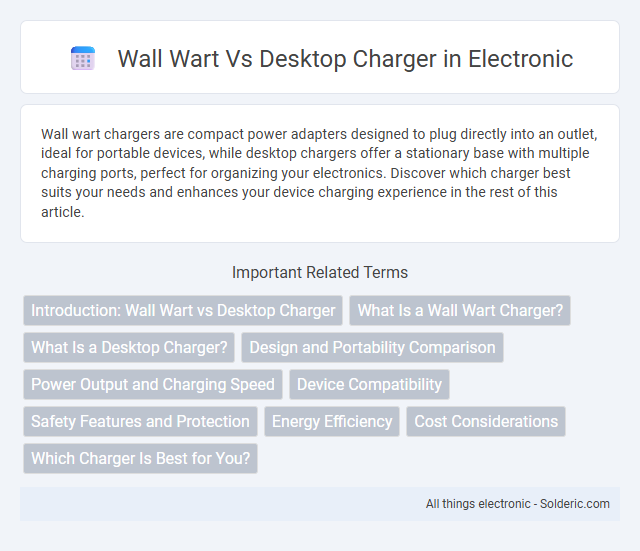Wall wart chargers are compact power adapters designed to plug directly into an outlet, ideal for portable devices, while desktop chargers offer a stationary base with multiple charging ports, perfect for organizing your electronics. Discover which charger best suits your needs and enhances your device charging experience in the rest of this article.
Comparison Table
| Feature | Wall Wart Charger | Desktop Charger |
|---|---|---|
| Design | Compact, plugs directly into wall outlet | Standalone unit, requires space on desk or surface |
| Portability | Highly portable, easy to carry | Less portable, bulkier |
| Charging Capacity | Usually single device, lower power output | Can charge multiple devices simultaneously, higher output |
| Use Case | Travel, on-the-go charging | Home or office, multi-device management |
| Power Source | Direct AC from wall outlet | Plug-in with integrated power supply |
| Price Range | Typically lower cost | Generally higher cost |
| Durability | Less robust due to compact design | More durable, designed for frequent use |
| Example Brands | Anker, Belkin, Aukey | Logitech, Satechi, Twelve South |
Introduction: Wall Wart vs Desktop Charger
Wall warts are compact, external power adapters that plug directly into a wall outlet, commonly used for charging small electronic devices with low power requirements. Desktop chargers are larger, stationary units designed to accommodate multiple devices or provide faster charging for higher-capacity batteries, often featuring advanced charging technology such as USB-C Power Delivery. Choosing between a wall wart and a desktop charger depends on the charging speed, device compatibility, and portability needs of the user.
What Is a Wall Wart Charger?
A wall wart charger is a compact power supply unit that plugs directly into a wall outlet, converting AC electricity to the DC voltage required by electronic devices. Unlike desktop chargers, wall warts are designed to be space-saving and portable, often eliminating the need for a bulky base or stand. Their built-in transformer and circuitry enable efficient charging for smartphones, tablets, and other small electronics.
What Is a Desktop Charger?
A desktop charger is a stationary power adapter designed to charge multiple devices simultaneously, often featuring several USB ports or charging slots for smartphones, tablets, and other electronics. Unlike wall warts that plug directly into an outlet, desktop chargers usually sit on a desk or table, providing a centralized charging hub with organized cable management. These chargers offer higher power output and enhanced convenience, making them ideal for office or home use where multiple devices need charging at the same time.
Design and Portability Comparison
Wall wart chargers feature a compact design that plugs directly into an electrical outlet, making them highly portable for travel and space-saving in tight environments. Desktop chargers, often bulkier and requiring a flat surface, provide stable support for multiple devices but sacrifice portability due to their size and weight. The choice depends on the balance between convenience and functionality, with wall warts excelling in portability and desktop chargers offering enhanced usability for stationary setups.
Power Output and Charging Speed
Wall warts typically offer higher power output ranging from 5W to 30W or more, enabling faster charging speeds for devices such as smartphones and tablets. Desktop chargers often provide multiple USB ports with varying power outputs, but individual port power may be lower compared to dedicated wall warts, potentially resulting in slower charging times per device. Choosing a charger with a higher wattage rating, such as 18W or above, supports rapid charging protocols like Qualcomm Quick Charge and USB Power Delivery, enhancing overall efficiency.
Device Compatibility
Wall warts typically offer limited device compatibility due to fixed voltage and amperage outputs designed for specific gadgets. Desktop chargers provide versatile compatibility, featuring multiple ports and adjustable power delivery to support smartphones, tablets, laptops, and other USB-powered devices. Choosing a desktop charger ensures broader device support and adaptability for evolving tech ecosystems.
Safety Features and Protection
Wall wart chargers often include built-in safety features such as overcurrent protection, short circuit prevention, and temperature regulation to prevent overheating. Desktop chargers typically offer advanced safety mechanisms like surge protection, automatic shutoff when devices are fully charged, and multiple output safeguards to protect connected electronics. Both types prioritize user safety by incorporating certified components that comply with international safety standards such as UL, CE, and FCC.
Energy Efficiency
Wall wart chargers typically consume more standby power compared to desktop chargers, resulting in lower overall energy efficiency. Desktop chargers often feature energy-saving technology and integrated power management systems that reduce electricity consumption when devices are fully charged or idle. Selecting a desktop charger can lead to significant energy savings and lower utility costs over time, especially with frequent device charging.
Cost Considerations
Wall wart chargers generally offer a more cost-effective solution compared to desktop chargers due to their compact design and lower manufacturing expenses. Desktop chargers tend to have higher production costs, which are reflected in their price, often including additional features like multiple charging ports or integrated stands. Choosing a wall wart charger can reduce upfront costs while providing sufficient power for most devices, making it an economical choice for budget-conscious consumers.
Which Charger Is Best for You?
When choosing between a wall wart and a desktop charger, consider your device usage and portability needs. Wall warts offer compact, plug-in convenience ideal for travel and limited space, while desktop chargers provide multiple charging slots and easier cable management for home or office setups. Your best choice depends on whether you prioritize mobility or simultaneous charging capacity.
wall wart vs desktop charger Infographic

 solderic.com
solderic.com